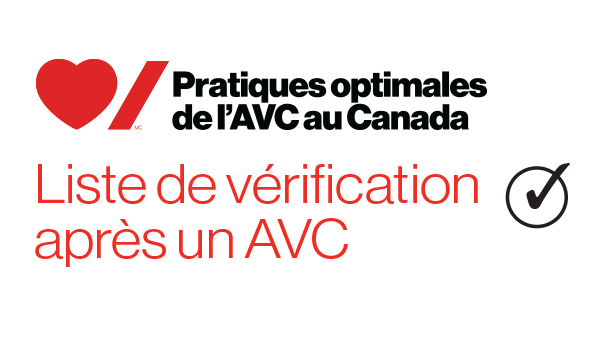- Définitions
- Éléments fondamentaux des services de prévention de l’AVC
- 1. Triage et évaluation diagnostique initiale de l’accident ischémique transitoire (AIT) et de l’AVC non invalidant
- 2. Prise en charge du mode de vie et des facteurs de risque
- 3. Pression artérielle et prévention de l’AVC
- 4. Prise en charge des lipides
- 5. Prise en charge du diabète et de l’AVC
- 6. Traitement antiplaquettaire des cas d’AVC ischémique et d’AIT
- 7. Traitement anticoagulant visant la fibrillation auriculaire
- 8. Prise en charge périopératoire du traitement anticoagulant et du traitement antiplaquettaire
- 9. Prise en charge de la maladie artérielle carotidienne extracrânienne et de l’athérosclérose intracrânienne
- 10. Problèmes cardiaques concomitants chez les personnes ayant subi un AVC
- 11. AVC ischémique associé au cancer
10. Problèmes cardiaques concomitants chez les personnes ayant subi un AVC
Recommendations
Remarque : Ces recommandations s’appliquent en cas d’AVC ischémique ou d’AIT.
10.1 Foramen ovale perméable (FOP)
- Les patients ayant récemment subi un AVC ischémique attribuable à un FOP devraient être évalués par des cliniciens ayant une certaine expertise en AVC et en maladies cardiovasculaires [niveau de preuve C].
- Chez des patients soigneusement sélectionnés qui ont récemment subi un AVC ischémique attribuable à un FOP, la fermeture du FOP ainsi qu’un traitement antiplaquettaire à long terme sont plus recommandés que le traitement antithrombotique seul à long terme, pourvu que tous les critères suivants soient respectés [niveau de preuve A] :
- Patient âgé de 18 à 60 ans.
- Le diagnostic de l’AVC de référence est confirmé par imagerie et il s’agit d’un AVC ischémique embolique non lacunaire.
- Le patient a été évalué par un neurologue ou un professionnel de la santé ayant une expertise en AVC, et il semble que, selon une évaluation étiologique ayant exclu toute autre étiologie probable, le FOP soit la cause la plus probable de l’AVC de référence.
- (Nouveau en 2020) : Il est raisonnable de recommander de ne pas fermer le FOP des patients qui ne présentent aucune des caractéristiques anatomiques à haut risque suivantes à l’échocardiographie : (a) anévrisme du septum interauriculaire; (b) grand shunt droit-gauche (par exemple, >20 microbulles); et (c) FOP de grand diamètre (par exemple, ≥ 2 mm) [niveau de preuve B].
- Chez les patients ayant besoin d’un traitement anticoagulant à long terme, l’avantage d’une fermeture du FOP demeure incertain, et le choix de traitement devrait se fonder sur les caractéristiques individuelles du patient ainsi que sur son profil risque/bienfaits [preuve C].
- Chez les patients ayant récemment subi un AVC ischémique attribuable au FOP qui n’auront pas de fermeture du FOP et qui ont 60 ans ou moins, un traitement antiplaquettaire ou anticoagulant est recommandé à titre de prévention secondaire de l’AVC, sauf en cas d’indication distincte fondée sur des données probantes quant à l’anticoagulothérapie chronique [niveau de preuve B].
Section 10.1 Facteurs cliniques
-
La warfarine peut réduire le nombre de récidives d’AVC; toutefois, cet avantage peut être contrebalancé par le risque accru d’hémorragie majeure.
-
Le rôle des AOD est inconnu au sein de cette population.
10.2 Athérome de la crosse aortique
- On doit prendre en charge l’athérome de la crosse aortique conformément aux recommandations de prévention de l’AVC qui se trouvent dans toutes les sections pertinentes du chapitre sur la prévention secondaire de l’AVC [niveau de preuve C].
- Lors de l’essai ARCH, aucune différence importante n’a été notée chez les patients traités à la fois par l’acide acétylsalicylique et le clopidogrel, comparativement à la warfarine; l’efficacité du traitement anticoagulant par rapport au traitement antiplaquettaire est incertaine dans ce contexte, et la décision doit être personnalisée [niveau de preuve B].
10.3 Insuffisance cardiaque, diminution de la fraction d’éjection du ventricule gauche, thrombus cardiaque
- Le traitement anticoagulant est recommandé pendant plus de 3 mois pour les patients ayant subi un AVC ischémique ou un AIT, qui ont un rythme sinusal et qui présentent un thrombus de l’oreillette ou du ventricule gauche à l’échocardiographie ou à tout autre test d’imagerie [niveau de preuve C].
- Chez les patients ayant subi un AVC ischémique ou un AIT, ayant un rythme sinusal et ayant un dysfonctionnement ventriculaire gauche grave (fraction d’éjection du ventricule gauche ≤35 %) sans signe de thrombus de l’oreillette ou du ventricule gauche, les bienfaits nets du traitement anticoagulant (par des antagonistes de la vitamine K ou des AOD) par rapport au traitement antiplaquettaire sont incertains, et la décision relative aux stratégies de prise en charge doit être personnalisée [niveau de preuve B].
Foramen ovale perméable
Pendant des années, le rôle de la fermeture percutanée d’un foramen ovale perméable (FOP) en prévention secondaire des AVC a fait l’objet de controverses, parce que (1) les FOP sont courants dans la population générale (25 %); (2) ils sont le plus souvent fortuits plutôt que pathogènes; et (3) les premiers ECR sur la fermeture du FOP par rapport au traitement médical n’étaient pas concluants. En 2017 et en 2018, la publication de deux nouveaux ECR et d’un suivi à long terme d’un précédent ECR a permis de démontrer que chez les patients soigneusement sélectionnés, la fermeture du FOP était supérieure au traitement médical pour ce qui est de la prévention de la récidive d’AVC (Saver J.L., et coll., Stroke 2018; 49:1541-8). Les méta-analyses des essais de FOP (Mir H. et coll. BMJ Open 2018;8:e 023761; Kent D.M. et coll. J Am Coll Cardiol 2016;67:907-17; Stortecky et coll. Eur Heart J 2015;36:120-8) appuient la fermeture du FOP chez des patients soigneusement sélectionnés, âgés de 60 ans ou moins, ayant subi un AVC embolique inexpliqué et dont on a découvert qu’ils avaient un FOP et qui n’ont pas besoin d’un traitement anticoagulant chronique pour une autre raison. La fermeture du FOP n’est pas recommandée chez les patients dont le FOP est probablement fortuit et non la cause de l’AVC de référence. Dans de telles circonstances, le traitement antiplaquettaire seul est recommandé pour la prévention de l’AVC secondaire, sauf s’il existe une indication distincte fondée sur des données probantes pour le traitement anticoagulant. Aucun des essais de FOP (sauf un) n’a inclus de patients âgés de plus de 60 ans. Par conséquent, sur la base des données probantes d’essais disponibles, la fermeture du FOP ne peut pas être recommandée chez les patients âgés victimes d’un AVC. La fermeture du FOP n’est pas recommandée pour la prévention primaire de l’AVC.
La recommandation relative à la fermeture du FOP accorde une grande importance à la prévention des AVC invalidants, en particulier chez les jeunes patients ayant une longue espérance de vie, et à la prévention des complications hémorragiques associées à un traitement anticoagulant de longue durée. La recommandation accorde moins de valeur au fait qu’un FOP est associé à un risque absolu annuel relativement faible de récidive d’AVC (1,2 % par année), qu’il y a souvent une incertitude quant à savoir si le FOP était vraiment le facteur causal, que la fermeture du FOP ne peut que prévenir les AVC liés au FOP et que dans une minorité de cas, la fermeture du FOP est incomplète, laissant un shunt résiduel. Si la réduction annuelle du risque absolu associé à la fermeture du FOP est faible, le bénéfice à long terme sur des décennies pour les jeunes patients peut devenir assez important. Les conseils aux patients et la prise de décision partagée, en tenant compte des valeurs et des préférences des patients, sont encouragés. Il existe des aides à la décision (MAGICapp: Patent foramen ovale closure, antiplatelet therapy or anticoagulation therapy for management of cryptogenic stroke; disponible à l’adresse : https://app.magicapp.org/#/guideline/2649). Les patients qui envisagent une fermeture de FOP doivent comprendre les avantages et les risques de la procédure et connaître les autres interventions possibles, ainsi qu’accepter le risque relativement faible de complications chirurgicales potentiellement graves, dont la fibrillation auriculaire. Dans la méta-analyse de Mir et coll., l’incidence globale des complications liées aux interventions était de 3,6 %, et on a constaté une augmentation absolue de 1,8 % du risque de fibrillation auriculaire persistante et de 1,2 % du risque de fibrillation auriculaire transitoire (Mir H. et coll. BMJ Open 2018;8:e 023761).
Il est essentiel de sélectionner soigneusement les patients pour lesquels la fermeture de FOP est envisagée. Le comité préconise la consultation d’un spécialiste des AVC et d’un cardiologue interventionnel expérimenté dont le taux de complications interventionnelles est faible. Un énoncé de consensus sur les normes techniques pour les opérateurs a été publié (Horlick et coll. Catheter Cardiovasc Interv 2019;93:859-874). La pertinence de la fermeture du FOP dépend (1) d’un diagnostic précis de l’AVC de référence et de l’exclusion des pseudo-AVC, et (2) d’un bilan étiologique approfondi pour exclure d’autres causes plus probables de l’AVC. Étant donné que l’AIT est parfois difficile à diagnostiquer (le surdiagnostic de l’AIT est un problème courant dans la pratique clinique, car de nombreux états peuvent lui ressembler et qu’aucun des essais sur le FOP (sauf un) n’a recruté de patients ayant subi un AIT à titre d’événement de référence, le comité s’est inquiété du potentiel d’interventions de fermeture du FOP inappropriées pour les patients atteints de pseudo-AIT. Par conséquent, l’AIT a été retiré des recommandations générales ci-dessus concernant la fermeture du FOP. Si la fermeture du FOP est proposée à un patient présentant un AIT, le diagnostic de l’AIT doit être convaincant, c’est-à-dire qu’il doit y avoir un degré élevé de certitude que l’événement de référence était un véritable événement ischémique cérébral, idéalement avec des symptômes corticaux et qu’il soit vérifié par un neurologue; tous les efforts doivent être faits pour obtenir des preuves par imagerie cérébrale pour confirmer l’ischémie embolique aiguë.
Insuffisance cardiaque
Chez les patients ayant subi un AVC ischémique ou un AIT et qui ont un thrombus auriculaire gauche ou ventriculaire gauche, un traitement anticoagulant par antivitamine K est recommandé pendant ≥ 3 mois (niveau de preuve C). 13 Dans l’essai randomisé WARCEF portant sur 2 305 patients souffrant d’insuffisance cardiaque (fonction ventriculaire gauche ≤35 %) et ayant un rythme sinusal, la warfarine a réduit le risque d’AVC ischémique, mais les bienfaits ont été contrebalancés par une augmentation des hémorragies majeures. Dans une méta-analyse de patients souffrant d’insuffisance cardiaque congestive avec une fraction d’éjection réduite, la warfarine a été comparée au traitement antiplaquettaire, et il y a eu une petite réduction absolue du risque d’AVC ischémique chez ceux qui étaient traités par la warfarine, mais les résultats étaient accompagnés d’un risque accru d’hémorragie majeure (principalement une hémorragie intracrânienne) et n’ont été associés à aucune réduction concomitante du nombre de décès, d’IM ou d’hospitalisations liées à une insuffisance cardiaque. Dans l’essai COMMANDER HF mené auprès de patients présentant une fraction d’éjection ventriculaire gauche réduite (40 %) en rythme sinusal, le rivaroxaban à une dose de 2,5 mg deux fois par jour n’a pas été associé à un taux significativement plus faible du résultat d’un critère d’évaluation multifactorielle de décès, d’IM ou d’AVC par rapport au placebo, bien que les AVC aient diminué.
Les personnes ayant subi un AVC, leur famille et leurs soignants ont exprimé le désir d’en savoir plus sur le lien entre le cœur et le cerveau. De nombreuses personnes ayant subi un AVC n’étaient pas au courant des affections abordées dans cette section, comme un FOP et ses liens potentiels avec l’AVC. Certaines personnes ayant subi un AVC ne savaient pas si elles avaient été examinées pour ces maladies et, si c’était le cas, quels en étaient les résultats.
Des personnes ayant subi un AVC et souffrant de troubles cardiaques concomitants ont décrit les difficultés que posent les systèmes de santé cloisonnés pour leurs soins. Par exemple, certains professionnels de la santé ne voulaient se concentrer que sur leurs affections liées à l’AVC et ne voulaient pas discuter d’autres facteurs, tels que les problèmes cardiaques. En outre, un manque de cohérence a été constaté dans la mise en commun de l’information entre les spécialistes et la possibilité d’offrir des soins plus intégrés et mieux coordonnés aux personnes présentant un éventail plus large de facteurs de risque vasculaire touchant à la fois le cœur et le cerveau.
- Intégration des soins pour les personnes souffrant de maladies cardiaques et d’AVC afin de gérer efficacement les rendez-vous et d’assurer la coordination des soins
- Soutien des recherches en cours sur l’étiologie chez les patients ayant subi un AVC cryptogénique.
- Soutien des recherches visant à déterminer l’incidence d’une correction chirurgicale de la perméabilité du foramen ovale par rapport à une autre forme de traitement.
- Proportion des personnes victimes d’un AVC en phase aiguë qui ont un foramen ovale perméable.
- Proportion de personnes atteintes d’un AVC ischémique en phase aiguë et d’un FOP qui sont traitées par des antiplaquettaires ou des anticoagulants (et un type spécifique d’anticoagulant : HFPM, warfarine ou AOD).
- Proportion de personnes atteintes d’un AVC ischémique en phase aiguë et d’un FOP qui subissent une procédure de fermeture du FOP.
- Temps médian entre l’AVC et la fermeture du FOP.
- Proportion de personnes atteintes d’un AVC ischémique en phase aiguë qui ont également un diagnostic d’insuffisance cardiaque.
- Délai médian entre le diagnostic de l’insuffisance cardiaque et l’AVC.
- Taux de mortalité des personnes souffrant d’une insuffisance cardiaque préexistante qui subissent un AVC aiguë (stratifié selon qu’il est ischémique ou hémorragique).
Notes sur la mesure des indicateurs :
- Tous les indicateurs de rendement doivent être classés par âge, sexe, type d’AVC et délai entre le diagnostic cardiaque et la survenue de l’AVC.
- Le FOP ne peut être détecté qu’après un AVC.
Renseignements destinés aux dispensateurs de soins de santé
- Cœur + AVC – Liste de vérification après un AVC
- Cœur + AVC – Votre cheminement après un AVC
- Cœur + AVC – Soutien en ligne par les pairs
- Thrombose Canada (en anglais)
- Société canadienne de cardiologie
- Société canadienne d’insuffisance cardiaque
- Canadian Cardiovascular Harmonized National Guidelines Endeavour (C-CHANGE) guideline for the prevention and management of cardiovascular disease in primary care: 2018 update
- Canadian Cardiovascular Harmonized National Guidelines Endeavour (C-CHANGE) guideline for the prevention and management of cardiovascular disease in primary care: 2018 update | CMAJ
Informations destinées au patient
- Cœur + AVC – Liste de vérification après un AVC
- Cœur + AVC – Soutien en ligne et par les pairs
- Cœur + AVC – Ressource sur les maladies du cœur
- Cœur + AVC – Collaborer avec votre médecin
- American Heart Association – Patent Foramen Ovale (en anglais seulement)
- Cœur + AVC – Bien vivre avec une maladie du cœur
- Cœur + AVC – Vivre avec une insuffisance cardiaque
- HeartLife
- Société canadienne d’insuffisance cardiaque – Ressources pour les patients
Other Cardiac Issues in Individuals with Stroke Evidence Table and Reference List
Patent foramen ovale (PFO)
Three earlier RCTs, CLOSURE 1 (Furlan et al. 2012), the PC Trial (Meier et al. 2013), and RESPECT (Carroll et al. 2013) investigated the effectiveness of PFO closure for reducing the risk of stroke recurrence and mortality following cryptogenic stroke, compared to medical management. Across the three trials, no significant reductions in the risk of the primary outcomes, which included recurrent stroke or transient ischemic attack and death, were associated with closure in their respective intention-to-treat analyses. The associated hazard ratios (HR were: 0.78 (95% CI 0.45 to 1.35, p=0.37) in CLOSURE 1, during 2-years follow-up; 0.63, (95% CI 0.24 to 1.62, p=0.34) in the PC trial after a mean of 4.1 years of follow-up, and 0.49, (95% CI 0.22 to 1.11, p=0.08) in RESPECT after a mean follow-up of 2.6 years. Whereas the authors of CLOSURE 1 and the PC trials both observed similar findings in per protocol-based analyses, the authors of RESPECT reported that in a per protocol analysis, PFO closure was associated with a significant reduction in the composite outcome of recurrent ischemic stroke or death, compared to medical therapy (HR= 0.37, 95% CI 0.14 to 0.96, p=0.03). There was no significant increase in the risk of serious adverse events in the intervention arm of any of the trials.
Results from recent trials including CLOSE (Mas et al. 2017), REDUCE (Sondergaard et al. 2017), DEFENSE-PFO (Lee et al. 2018), and long-term results of the RESPECT trial (Saver et al. 2017), have demonstrated that among carefully selected patients PFO closure is superior to medical therapy for prevention of stroke recurrence.
In the CLOSE trial, Mas et al. (2017) enrolled 633 patients aged 16–60 years (mean age approximately 43 years) who had experienced a recent stroke with no identifiable cause other than a PFO, following detailed etiological work- up by a neurologist. The PFO had to be associated with either an atrial septal aneurysm (excursion >10 mm) or large interatrial shunt (>30 microbubbles in the left atrium within three cardiac cycles after opacification of the right atrium). Mean duration of follow-up was 5.3±2.0 years. The rate of recurrent stroke was 0 in the PFO-closure group compared with 6.0% in the antiplatelet-only group (mostly aspirin) (HR= 0.03; 95% CI 0-0.26; p<0.001; NNT=20 to prevent 1 stroke in 5 years; 95% CI 17-25). The rate of procedural complications in the PFO closure group was 5.9%, mostly consisting of atrial fibrillation (4.6% in the closure group vs. 0.9% in the antiplatelet group, p=0.02); most cases of atrial fibrillation were transient and did not recur during follow-up.
The REDUCE trial (Sondergaard et al. 2017) enrolled 664 patients aged 18–59 years (mean age 45.2 years) with a PFO with a right-to-left shunt (spontaneous or during Valsalva maneuver), of whom 81% had moderate (6-25 microbubbles) or large (>25 microbubbles) interatrial shunts. Median follow-up was 3.2 years. The risk of ischemic stroke was significantly lower in the PFO closure group compared with the antiplatelet-only group (1.4% vs. 5.4%, HR=0.23, 95% CI 0.09-0.62; p=0.002; NNT=28 to prevent 1 stroke in 2 years). Serious device-related adverse events occurred in 1.4% of patients. The frequency of new-onset atrial fibrillation or flutter was significantly higher in the PFO closure group (6.6% vs 0.4%, p<0.01); most cases of atrial fibrillation in the closure group were transient.
The RESPECT trial enrolled patients aged 18–60 years (mean age 45.9 years) with a cryptogenic stroke and PFO. In the extended follow-up analysis, during a median duration of follow-up of 5.9 years, the risk of recurrent ischemic stroke was significantly lower in the PFO closure group compared with the medical therapy group (antiplatelet therapy or warfarin) (3.6% vs. 5.8%; HR=0.55, 95% CI 0.31-0.999, p=0.046, NNT=42 to prevent 1 stroke in 5 years). In subgroup analysis, the benefit of closure appeared to be driven by those with an atrial septal aneurysm or a “substantial” shunt size (grade 3).
Lee et al. (2018) randomized 120 patients aged 18-80 years, with a cryptogenic ischemic stroke occurring within the previous 6 months with no identifiable cause other than a high risk PFO with right-to-left shunting to receive medical therapy with antiplatelet or anticoagulation alone, or PFO closure. Antiplatelet therapy included aspirin (100 mg/day), aspirin in combination with clopidogrel (75 mg/day), or aspirin in combination with cilostazol (200 mg/day). Dual antiplatelet therapy was used by most patients in both groups at 30 days and 6 months. At 12 months, more patients in the PFO group were taking a single antiplatelet, compared with the medical therapy group. Anticoagulants were used by ≤25% of patients at any assessment point. There were significantly more primary outcome events (recurrent stroke and major bleeding within 2 years) in the medication-only group (6 vs. 0, p=0.013), of which 5 were ischemic strokes. The authors estimated that the NNT to avoid one stroke at 2 years, was 10.
Clinical clues to the diagnosis of a PFO-related stroke event include stroke symptom onset preceded by a Valsalva maneuver, waking up with a stroke, sleep apnea, deep vein thrombosis or pulmonary embolism, respiratory symptoms at the time of stroke onset, and recent prolonged travel or immobilization (Ozdemir AO et al. J Neurol Sci 2008;275:121-7). History-taking should elicit whether there is a personal or family history of venous thromboembolism or high-risk thrombophilia. The Risk of Paradoxical Embolism (RoPE) score can help higher scores (younger age, cortical infarct, and absence of traditional vascular risk factors) predict that a PFO is more likely to be stroke-related than incidental (Kent DM et al. Neurology 2013;81:619-625).
There have been conflicting data on the significance of PFO size and uncertainty whether or not an isolated small PFO/small shunt without an atrial septal aneurysm should be closed. In meta-analysis of the PFO trials, the benefit of PFO closure over medical therapy was maximal in subgroups with a large PFO or substantial shunt or atrial septal aneurysm; in subgroups without any of those anatomical features, a significant benefit of PFO closure was not observed (Mas J-L et al. Archives of Cardiovascular Disease 2019;112:532-542; Turc G et al. J Am Heart Assoc 2018;7; Pristipino C et al. European Heart Journal 2018; Saver JL, et al. Stroke 2018;49:1541-8). However, it has been pointed out that the observed effect of shunt size may be confounded by a higher proportion of antiplatelet therapy rather than anticoagulation in the medical arms of the trials that enrolled more patients with larger shunts (Mir H et al. BMJ Open 2018;8: e023761). According to Saver et al., the NNT to prevent 1 stroke over 5 years with PFO closure plus antiplatelet therapy (versus antiplatelet therapy alone) is 24 overall. For PFO closure versus medical therapy, the NNT to prevent 1 stroke in 5 years is lower among patients with an atrial septal aneurysm (NNT=13) and among patients with moderate-large shunts (NNT=18) (Saver JL, et al. Stroke 2018;49:1541-8).
There remains uncertainty about the relative effectiveness of anticoagulant therapy versus antiplatelet therapy for patients with a stroke and PFO (without atrial fibrillation) who do not undergo PFO closure. In the PFO subgroup analyses from the ESUS trials, there was a (non-significant) trend in favour of DOAC therapy over aspirin in the NAVIGATE ESUS trial (Kasner SE et al. Lancet Neurol 2018;17:1053-1060) but not in the RESPECT ESUS trial (Diener HC et al. NEJM 2019;380:1906-1917). In the CLOSE trial, there were numerically fewer recurrent stroke events among patients assigned to the anticoagulation arm (in which 93% received a vitamin K antagonist and 7% received a DOAC) compared with the antiplatelet arm, but this comparison was underpowered. An updated meta-analysis of 5 trials found a non-significant trend in favour of anticoagulation over antiplatelet therapy (Sagris D, et al. Stroke 2019;50). Anticoagulation has the advantage of providing protection against both arterial and venous thromboembolic events beyond the PFO, and hence would probably be preferred for patients with unprovoked deep vein thrombosis or pulmonary embolism or a high-risk thrombophilia.
When the results of 6 RCTs (CLOSURE, PC, RESPECT, GORE-Reduce, CLOSE and DEFENSE PFO) were pooled (Turc et al. 2018), the risk of recurrent stroke is significantly lower in the PFO group, compared with antithrombotic therapy (37/1,889 vs. 79/1,671; RR= 0.36, 95% CI 0.17-0.79, p=0.01).
Sex and Gender Considerations: In a single centre study including patients admitted for recent ischemic stroke and referred for transesophageal echocardiography (TEE), the prevalence of PFO was similar in men and women (32.4% vs. 28.2%, p= 0.15, respectively). (Gupta et al. 2008). In a pooled analysis of 5 RCTs, the risk of recurrent stroke was significantly lower in men who had undergone PFO closure compared with medical management (OR=0.32, 95% CI=0.14–0.73, p=0.01), but was not in women (OR=0.84, 95% CI=0.47–1.51, p=0.56) (Agasthi et al. 2019).
Aortic Arch Atheroma
The definitive management of patients with aortic arch plaques is unclear. Typically, monotherapy with an antiplatelet agent or oral anticoagulation is used to prevent further events in patients with a prior ischemic stroke. Amarenco et al. (2014) tested the hypothesis that dual antiplatelet therapy would be superior to oral anticoagulation. The Aortic Arch Related Cerebral Hazard Trial (ARCH) included 351 patients with a previous ischemic stroke, transient ischemic attack, or peripheral embolism with plaque in the thoracic aorta >4 mm and no other identified embolic source. Patients were randomized to receive 75 to 150 mg/d aspirin + 75 mg/d clopidogrel or dose-adjusted warfarin with a target INR of 2.5 (2-3) for the duration of the trial. After a median of 3.4 years of follow-up, the risk of the primary outcome, a composite of cerebral infarction, myocardial infarction, peripheral embolism, vascular death, or intracranial hemorrhage was not significantly lower in the dual therapy group (7.6% vs. 11.3%, HR=0.76, 95% CI 0.36-1.61, p=0.50). There was no significant difference in the occurrence of major hemorrhages between groups (2.3% for dual therapy vs. 3.4% for warfarin, p=0.2).
Risk of Recurrent Stroke Associated with Heart Failure
Heart failure is known to be associated with increased risk of recurrent stroke. Katsanos et al. (2016) included the results from 7 studies (n=9,173) that reported the recurrence of ischemic stroke in patients with heart failure. The definitions used for heart failure were based on medical history (n=3), ejection fraction (n=1), Framingham criteria (n=1) or were not reported (n=3). Within the included studies, the percentage of patients with heart failure ranged from 4.8% to 33.9%. The mean follow-up durations across the included studies ranged from 7 days to 5 years. The risk of recurrent stroke was significantly increased among patients with heart failure (RR=1.96, 95% CI 1.49 -2.60, p<0.0001). Using data from the Canadian Stroke Registry, Pongmoragot et al. (2016) compared the outcomes of 12,396 patients admitted to hospital following an ischemic stroke with heart failure versus those without. Heart failure was defined either as pre-existing, or pulmonary edema present at the time of arrival to hospital. While the number of patients with stroke recurrence at 30 days did not differ between groups (3.9% vs. 3.2%, p=0.194), stroke fatality at discharge, 30 days and 1 year was significantly higher for patients with heart failure. Heart failure was also an independent predictor of death or disability at discharge (OR=1.18, 95% CI 1.01-1.37), 30-day survival (HR=1.22, 95% CI 1.05-1.41) and 30-day readmission (OR=1.32, 95% CI 1.05-1.65), after adjusting for age, sex, stroke severity and medical comorbidities.
Stroke Prevention for Patients in Heart Failure
The effectiveness of anticoagulation compared with antiplatelet therapy for stroke prevention in patients with heart failure in sinus rhythm remains unclear. Although several trials have compared their relative effectiveness, the superiority of any one approach has not been demonstrated. Most recently, the COMMANDER-HF trial (Zannad et al. 2018) randomized 5,081 participants in sinus rhythm with chronic heart failure, a left ventricular ejection fraction (LVEF) of ≤40%, with coronary artery disease and who had been treated for an episode of worsening heart failure within the previous 21 days, to receive 2.5 mg rivaroxaban twice daily or matching placebo in addition to standard care (including mono or dual antiplatelet therapy). After a median of 21.1 months, there was no difference between groups in the risk of the primary composite outcome of death from any cause, MI, or stroke (rivaroxaban 13.44 events/100 persons years vs. placebo 14.27 events/100-person years; HR=0.94, 95% CI 0.84–1.05, p=0.27), although the risk of stroke was reduced significantly in the rivaroxaban group (1.08 vs. 1.63 events/100-person years; HR=0.66, 95% CI 0.47–0.95).
The Warfarin versus Aspirin in Reduced Cardiac Ejection Fraction (WARCEF) trial included 2,305 patients with LVEF ≤35% (Homma et al. 2012). Patients were randomized to receive 325 mg aspirin daily or warfarin with a target INR of 2.75 for the study duration. After an average of 3.5 years, the rates for the primary outcome, a composite outcome of time to first event of ischemic stroke, intracerebral hemorrhage or death from any cause, were similar between groups (7.47 and 7.93 events/100 patient years for warfarin and aspirin, respectively: HR for warfarin=0.93, 95% CI 0.79-1.10, p=0.40). Although warfarin was associated with a significantly reduced risk of ischemic stroke (HR=0.52, 95% CI 0.33-0.82, p=0.005), the risks of major and minor hemorrhages were significantly increased. A subgroup analysis of the WARCEF trial (Homma et al. 2013) found that patients <60 years treated with warfarin had a significantly lower risk of the primary outcome (HR=0.63, 95% CI 0.48-0.84, p=0.003) compared with aspirin therapy, while there was no significant treatment effect for patients 60 years or older. Patients <60 years treated with warfarin had a significantly lower risk of the primary outcome plus any major hemorrhage (HR=0.68, 95% CI 0.52-0.89, p=0.005). Patients ≥60 years treated with warfarin had a higher risk (HR=1.25, 95% CI 1.02-1.53, p=0.03) compared with aspirin. Investigators of the Warfarin and Antiplatelet Therapy in Chronic Heart Failure (WATCH) Trial compared 162 mg aspirin daily versus 75 mg clopidogrel daily versus warfarin, with target INR of 2.5 to 3.0 in patients in heart failure with a LVEF ≤35% (Massie et al. 2009). The risk of the primary outcome was similar between groups (20.7% aspirin vs. 21.6% clopidogrel vs. 19.6% warfarin). While warfarin was associated with a decreased risk of nonfatal and total stroke compared with either antiplatelet agent, the risk of bleeding events was significantly higher among patients in the warfarin group compared with clopidogrel.






